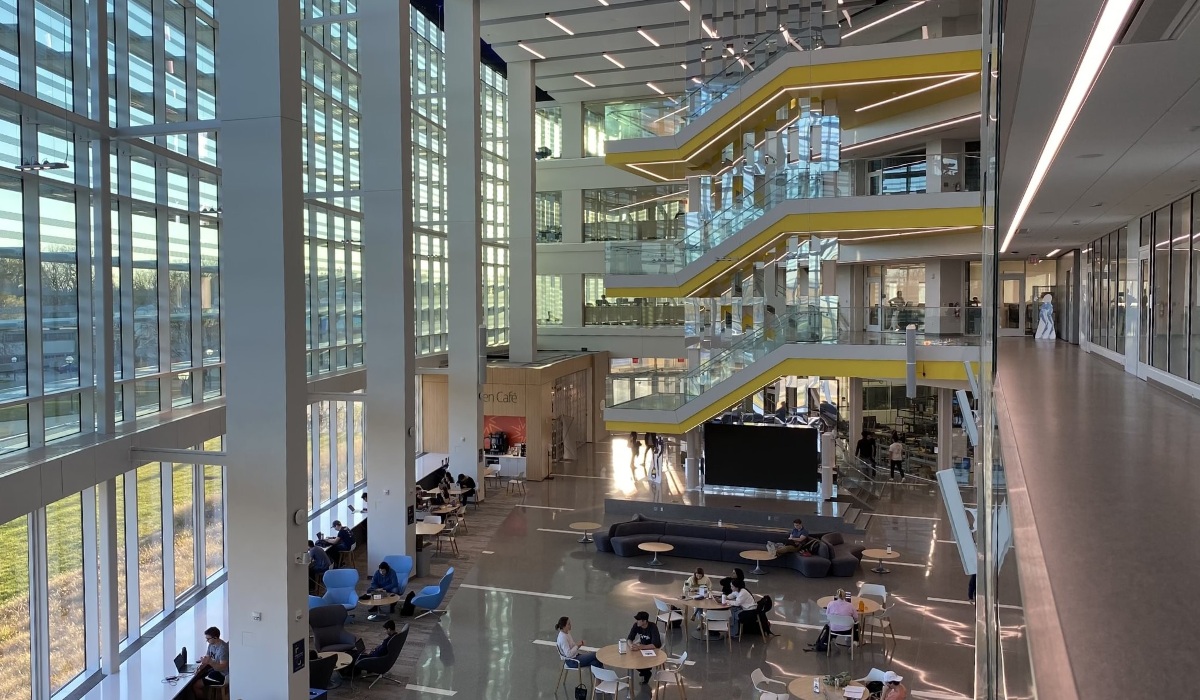Listen closely: buzzing catches your attention before you see the drone, flying above. An unmanned vehicle scoots past you. Look outside: a rover climbs a tricky rock garden that looks like the surface of Mars. You’re not on the set of a sci-fi movie. Welcome to the U-M Robotics Institute.
The Ford Motor Co. Robotics Building, a four-story, 134,000-square-foot complex on North Campus, houses the Institute on the first three floors. Ford engineers and researchers, about 100 of them, work on the fourth floor, often collaborating with U-M students and faculty.
It cost $75 million to build the complex, and it’s no wonder. In addition to classrooms, offices, and a 2,600-square-foot Makerspace with 3D printers, laser cutters, and other equipment, the building contains labs for robots that fly, walk, and roll.
Here, researchers test drones and other autonomous aerial systems in a three-story fly zone as high-speed motion-capture cameras track their movements.
“Indoors, aerial systems can be tested without encountering wind or weather, and performance can be measured with an array of motion capture cameras,” says the Institute’s managing director, Damen Provost.
But aircraft must experience adverse conditions to prepare for the real world. So, just outside is the M-Air Outdoor Test Facility, a 9,600-square-foot space enclosed in four stories of netted walls. In this 50-foot high area, wind, lightning, and other natural conditions give aircraft a chance to throttle motors and pitch or roll in response.
Prefer to drive? 12-foot-high doors on a high-bay garage accommodate every kind of self-driving vehicle.
“The High Bay is outfitted with EV [electric vehicle] chargers and high-speed connectivity,” Provost says. “From full-sized, level five AV [audio-visual] prototypes to perception sensor demonstrations to a water tank for AUVs [autonomous underwater vehicles], the High Bay serves as a working research space for field testing and demonstrations.”
But even a state-of-the-art garage has limits. So, just a mile west is the Mcity Test Facility, where automated vehicles drive around a 32-acre site resembling a city.
Roundabouts, ramps, sidewalks, multi-lane freeways, tunnels, a railroad crossing, streetlights and signals, and diverse kinds of terrain — grass, dirt, gravel, pavement, some with faded lane markings — give robotic cars exposure to varying roads they will encounter. Mannequins, outfitted with sensors, serve as pedestrians.
In the center of this small-scale Ann Arbor is a bright maize “M” on a large blue circle.
Robots don’t always stay close to home. Scientists at U-M and NASA helped plan the Mars Yard, where teams send rovers onto red soil and material similar to the Martian surface. Rovers climb and descend rocky terrain and test samples of the soil.
MRover, a student-run, multidisciplinary Mars rover team, designs and builds a rover that can explore extraterrestrial environments — and competes in an annual challenge against other universities.
In the McNeil Walking Robotics Laboratory, an in-ground treadmill can hit 31 mph and a 20 percent grade. Outside, in the Robot Garden, bipedal robots climb stairs and traverse rocky surfaces and water, encountering everything from twigs to holes hidden by grass coverings.
They call this the “robot playground,” but it — and other areas at the Robotics Institute — pose challenges to man and machine as dedicated teams work to change the way we live.
Davi Napoleon, ’66, MA’68, is a freelance writer and theater historian.





